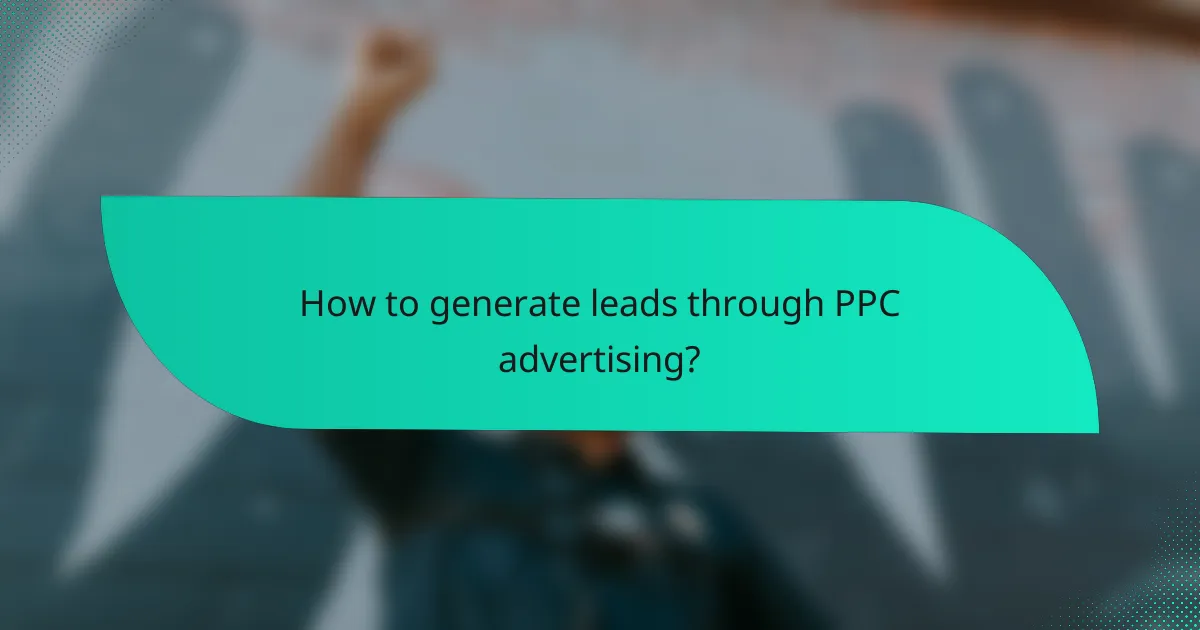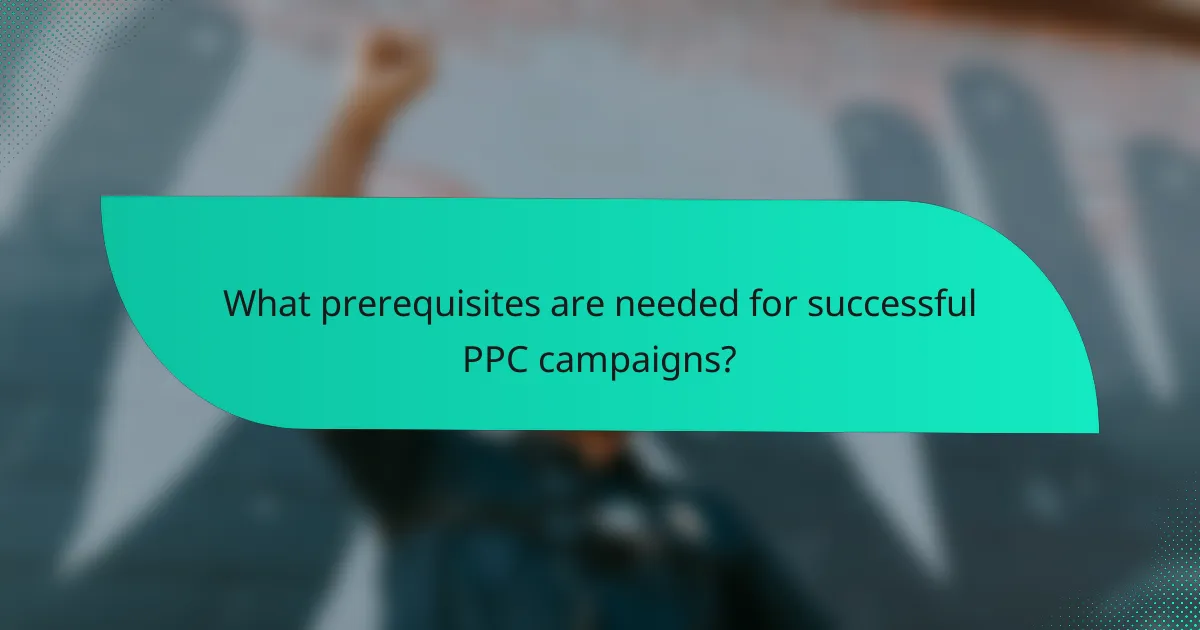PPC advertising campaigns are a powerful tool for driving immediate traffic and enhancing online visibility, particularly in competitive markets like London. By targeting specific audiences, businesses can quickly attract potential customers, while effective ROI tracking metrics enable advertisers to assess and optimize their campaign performance. Additionally, well-crafted ads and strategic landing pages play a crucial role in generating valuable leads and conversions.

How can PPC advertising campaigns boost traffic in London?
PPC advertising campaigns can significantly enhance traffic in London by providing immediate visibility on search engines and targeting specific audiences. This method allows businesses to attract potential customers quickly and effectively, leading to increased website visits and potential conversions.
Immediate visibility on search engines
PPC campaigns offer instant placement on search engine results pages, ensuring that your ads appear at the top when users search for relevant keywords. This immediate visibility can lead to a rapid influx of traffic, especially for businesses looking to promote time-sensitive offers or events.
For example, a local restaurant running a PPC campaign for a limited-time discount can attract customers quickly, driving foot traffic and online orders. This is particularly beneficial in competitive markets like London, where standing out is crucial.
Targeted audience engagement
PPC advertising allows for precise targeting based on demographics, interests, and behaviors, ensuring that your ads reach the most relevant audience. This targeted approach increases the likelihood of engagement, as users who see your ads are more likely to be interested in your products or services.
In London, businesses can utilize geo-targeting to focus on specific neighborhoods or areas, maximizing their ad spend efficiency. For instance, a boutique in Shoreditch can target ads to users within a few miles, enhancing local engagement and driving traffic to their store.
Cost-effective ad placements
PPC campaigns can be cost-effective, allowing businesses to set budgets that align with their financial goals. Advertisers only pay when users click on their ads, making it easier to track return on investment (ROI) and adjust strategies as needed.
In London, where advertising costs can vary widely, businesses should regularly analyze their PPC performance to ensure they are getting the best value. Setting daily or monthly spending limits can help control costs while still driving significant traffic to your website.
![]()
What are the key metrics for tracking ROI in PPC campaigns?
The key metrics for tracking ROI in PPC campaigns include cost per click (CPC), conversion rate, and return on ad spend (ROAS). These metrics help advertisers evaluate the effectiveness of their campaigns and make informed decisions to optimize performance.
Cost per click (CPC)
Cost per click (CPC) measures the amount spent on each click in a PPC campaign. It is calculated by dividing the total cost of the campaign by the number of clicks received. Keeping CPC low while maintaining high-quality traffic is crucial for maximizing ROI.
To manage CPC effectively, consider setting a maximum bid limit for keywords based on their performance. Regularly review and adjust bids to ensure you are not overspending on low-performing keywords.
Conversion rate
The conversion rate indicates the percentage of visitors who take a desired action, such as making a purchase or filling out a form. It is calculated by dividing the number of conversions by the total number of clicks, then multiplying by 100. A higher conversion rate signifies a more effective campaign.
To improve conversion rates, focus on optimizing landing pages, ensuring they are relevant to the ad content and user intent. A/B testing different elements, such as headlines and calls to action, can also help identify what resonates best with your audience.
Return on ad spend (ROAS)
Return on ad spend (ROAS) measures the revenue generated for every dollar spent on advertising. It is calculated by dividing total revenue by total ad spend. A ROAS of 4:1, for example, means that for every dollar spent, four dollars are earned back.
To achieve a favorable ROAS, regularly analyze which campaigns and keywords yield the highest returns. Adjust your budget allocation to focus on high-performing areas while reconsidering or pausing underperforming campaigns to enhance overall profitability.

How to generate leads through PPC advertising?
Generating leads through PPC advertising involves creating targeted ads that drive traffic to your website, where potential customers can convert. By focusing on compelling ad copy, effective landing pages, and retargeting strategies, you can maximize your lead generation efforts.
Creating compelling ad copy
Compelling ad copy is crucial for attracting clicks and generating leads. Use clear, concise language that highlights the benefits of your product or service, and include a strong call to action (CTA) that encourages users to take the next step.
Consider using emotional triggers or urgency to entice potential customers. Phrases like “limited time offer” or “join thousands of satisfied customers” can create a sense of urgency that prompts immediate action.
Utilizing landing pages effectively
Landing pages should be designed specifically for the PPC campaign to ensure consistency and relevance. Make sure the messaging aligns with the ad copy and clearly communicates the value proposition.
Incorporate elements like testimonials, clear CTAs, and minimal distractions to enhance user experience. A/B testing different layouts and content can help identify which versions convert better.
Implementing retargeting strategies
Retargeting strategies allow you to reach users who have previously interacted with your ads or website. By displaying tailored ads to these individuals, you can remind them of your offerings and encourage them to return and convert.
Consider segmenting your audience based on their behavior, such as those who visited specific pages or abandoned a cart. This targeted approach can significantly improve your conversion rates and overall ROI from PPC campaigns.

What prerequisites are needed for successful PPC campaigns?
Successful PPC campaigns require a clear understanding of your target audience, well-defined campaign goals, and a realistic budget. These elements form the foundation for creating effective ads that generate immediate traffic and a positive return on investment.
Understanding target audience
Identifying your target audience is crucial for tailoring your PPC campaigns. This involves researching demographics, interests, and online behaviors to ensure your ads reach the right people. Utilize tools like Google Analytics and social media insights to gather data about potential customers.
Once you have a clear picture of your audience, create buyer personas to guide your ad messaging and targeting strategies. This helps in crafting compelling ads that resonate with your audience’s needs and preferences.
Defining campaign goals
Clearly defined campaign goals are essential for measuring success and optimizing performance. Common goals include increasing website traffic, generating leads, or boosting sales. Establish specific, measurable objectives to track progress effectively.
For example, if your goal is lead generation, you might aim to achieve a certain number of sign-ups or inquiries within a specific timeframe. This clarity allows you to adjust your strategies based on performance data.
Setting a budget
Establishing a budget is a critical step in planning your PPC campaigns. Determine how much you are willing to spend daily or monthly, and consider factors like keyword competitiveness and expected click-through rates. A typical starting budget might range from a few hundred to several thousand dollars, depending on your industry and goals.
Monitor your spending closely and adjust your budget based on the performance of your ads. Avoid overspending by setting limits on bids and using tools to track your return on investment, ensuring that your campaigns remain cost-effective.

How do PPC campaigns compare to SEO for lead generation?
PPC campaigns provide immediate traffic and lead generation, while SEO focuses on long-term growth. Both strategies have their merits, but the choice depends on your business goals and timeline.
Immediate results vs. long-term growth
PPC campaigns can generate traffic almost instantly, often within hours of launching an ad. This is ideal for businesses needing quick lead generation, such as during a product launch or seasonal promotion.
In contrast, SEO is a gradual process that builds organic traffic over time. It may take several months to see significant results, but the leads generated through SEO can be more sustainable and cost-effective in the long run.
Cost implications of paid vs. organic traffic
PPC advertising typically involves a pay-per-click model, meaning you pay for each click on your ad. Costs can vary widely depending on the industry, competition, and keywords, often ranging from a few cents to several dollars per click.
SEO, while initially less costly, requires investment in content creation, optimization, and potentially ongoing maintenance. Over time, organic traffic can lead to lower customer acquisition costs compared to PPC, making it a valuable long-term strategy.